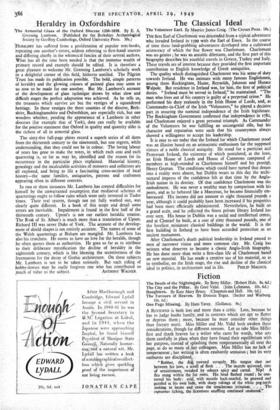Heraldry in OkfOrdshire
HERALDRY has suffered from a proliferation of popular text-books, repeating one another's errors, seldom referring to first-hand sources and differing chiefly in the whimsical fancies of their several authors. What has all the time been needed is that the immense wealth of primary record and example should be edified. It is therefore a great pleasure to welcome Mr. Greening Lamborn's scholarly work in a delightful corner of this field, hitherto unfilled. The Pilgrim Trust has made its publication possible. The bold, simple patterns of heraldry and the glowing colours of painted glass may seem to us now to be made for one another. But Mr. Lambom's account of the development of glass technique shows by what slow and difficult stages the perfect adaptation was achieved. As he tells us, the treasures which survive are but the vestiges of a squandered heritage. In these vestiges the three counties of the diocese, Berk- shire, Buckinghamshire and Oxfordshire, are especially rich, but one wonders whether, pending the appearance of a Lamborn in other dioceses (for example that of York), data can really be available for the positive statement that Oxford in quality and quantity alike is the richest of all in armorial glass.
The sixty-five full-page plates record a superb series of all dates from the thirteenth century to the nineteenth, but one regrets, while understanding, that they could not be in colour. The loving labour of years has gone to make the notes, in which each coat and each quartering is, so far as may be, identified and the reason for its occurrence in the particular place explained. Manorial history, genealogy and the incalculable activities of restorers and collectors are all explored, and bring to life a fascinating cross-section of local history—the same families, antiquaries, patrons and craftsmen appearing often in different contexts.
In two or three instances Mr. Lamborn has created difficulties for himself by the unwarranted assumption, that mediaeval schemes of quarterings ought to follow rules which were only invented in Tudor limes. Their real system, though not yet fully worked out, was clearly quite different. In a book of this scope and detail some errors are inevitable. Impalement is found in the first half of the thirteenth century. Upton's is not our earliest heraldic treatise. The 1330k of St. Alban's is much more than a translation of Upton. Richard III was never Duke of York. The account of the develop- ment of shield shapes is not entirely accurate. The names of some of the Welsh quarterings at Bisham are mangled. Mr. Lamborn has also his crotchets. He seems to have no love for the heralds, though be often quotes them as authorities. He goes so far as to attribute to their deliberate mystification the decline of heraldry in the eighteenth century, which is like blaming the secretiveness of the freemasons for the decay of Gothic architecture. On these subjects Mr. Lamborn is not to be taken seriously. But such riding of bobby-horses may be easily forgiven one who has contributed so


































 Previous page
Previous page